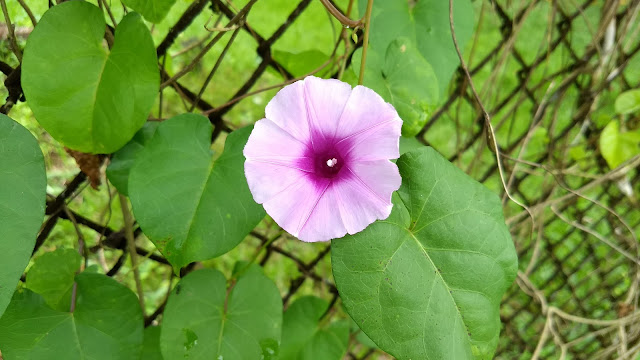Vegetative morphology walk and identification
A week of rain was punctuated by a day where the rain fell only between my classes. From 8:00 to 1:00 the rain held off for physical science, then the sky opened up and heavy rain fell. The rain broke off by 2:30 and the 3:30 ethnobotany class walked on wet ground under dry skies.
I began with the Eugenia uniflora as this has simple pinnate leaf with opposite arrangement and a nicely elliptical (oval on the handout) leaf. Then I headed down to the Terminalia catappa with its obovate leaf and whorled arrangement. From there to the compound leaf of Pterocarpus indicus and thence on down to Volkameria inermis, Ocimum tenuiflorum, Scaevola taccada, Mangifera indica (lanceolate), Artocarpus altilis (deeply lobed) a Cocos nucifera frond, Macaranga carolinense (palmate venation, roughly deltoid leaf), Senna alata, Hibiscus tiliaceus (cordate). This left us down in the corner near the well, so I cut through to the soccer field in search of an Acacia auriculiformis sapling that I knew would have some falcate leaves.
I found some Chromolaena odorata in this stretch of the walk. Earlier a student had noted that they do not like the smell of Ocimum tenuiflorum, so I offered them Chromolaena and suggested they might prefer the smell of Chromolaena. After they recovered from the bad smell, I noted the local name of the plant.
Acacia auriculiformis (tenative) sapling which had one particularly falcate leaf on it. While here I also covered Campnosperma brevipetiolatum and the orbicular leaf of Merremia peltata.
Courses evolve over time. As the final examination plant list grew from an original list of twelve plants to over seventy plants, the load of learning the plants has increased significantly. With this in mind, more activities are oriented towards the theme of learning the names of the plants, Latin, local, and their local use. Add to this the rather phenomenal collapse in plant knowledge among students, just as amazing collapse, such that now the local names are as much a memorization task as the Latin names.
For many years this was a plant leaf walk and talk with roots in the botany class I taught in the late 1990s. Then, for a couple terms vegetative morphology was covered by a leaf hunt. At the end of the hunt, however, I could not really show learning had occurred.
A couple terms ago I returned to the leaf shape walk and talk but with a new list that focused primarily on shape, a list left over from the leaf shape hunt activity. This term I realized I could alter the layout of the handout and run the exercise as a final examination preparation. Bear in mind that the final examination is an authentic assessment aligned to the learning outcomes of the course. This led to a new handout this term with leaf shapes, and fill in the blank Latin codes, local names, and local uses.
The Latin codes are on the back.
The students do not have to memorize seventy some Latin names, just pick the correct one from the list. Still a daunting task.
IPO: Ipomoea littoralis (cordate)
PIN: Piper nigrum (elliptical, smooth margin)
Leeron followed by Nemely, Nette, and Myra
Nemely, Lavonna, Nette, in the Ischaemum polystachyum (linear venation, linear leaf shape)
I found some Chromolaena odorata in this stretch of the walk. Earlier a student had noted that they do not like the smell of Ocimum tenuiflorum, so I offered them Chromolaena and suggested they might prefer the smell of Chromolaena. After they recovered from the bad smell, I noted the local name of the plant.
Rodrigo, Nemely
Acacia auriculiformis (tenative) sapling which had one particularly falcate leaf on it. While here I also covered Campnosperma brevipetiolatum and the orbicular leaf of Merremia peltata.
Then I headed south to pick up the reniform leaf shape, dentate margins, of Centella asiatica.
Ian en route to the Ponapea ledermanniana
Rayden, Melissa, Nemely out in front
A student had earlier misidentified Gardenia jasminoides (iosep) as Jasminum sambac (sampakihda), so our last stop was at the Gardenia taitensis and Jasminum sambac.















Comments
Post a Comment